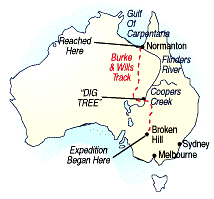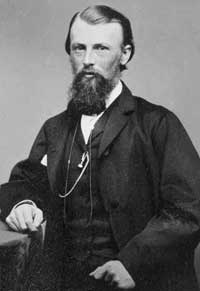| The Burke and Wills Expedition of 1860 |
|---|
| In 1860, 16 men led by Robert O'Hara Burke, set out from Menindee near Broken Hill to traverse the continent from south to North. Of the lead party which succeeded in reaching the Gulf of Carpentaria, only one survived. |
|
|
|
| The Expedition |
|---|
|
On the 20th. of August, 1860, Robert O'Hara Burke led an expedition
of 16 men out of Melbourne with the ambition of being the first persons
to cross the continent from south to north. The idea was to open up a route by which the new-fangled invention of the telegraph line could be connected via Java to Europe, to explore whether there existed a large inland sea, and to discover a possible route for a railway. An added incentive was a 2,000 pounds reward for the first people to survey a route north, and already, Sturt and Stuart were planning similar journeys from Adelaide. Burke was to lead the expedition with Wills as surveyor and they took a 2 year supply of food, as well as 80 pairs of shoes, beds, hats and buckets. At the Darling River, Wright and Gray joined the crew and led them to Coopers Creek where, on Nov. 11th., they set up base camp. It was at this point things began to go wrong. After a long wait at the base camp for the others to reach them with additional supplies, an impatient Burke decided to leave with Wills, King and Gray anyway and worry about the additional supplies when they returned. Arduous conditions, intense summer heat, and problems with dysentry and health delayed their return from the Gulf which they reached in Feb. 1861, and the party waiting at the base camp had left the previous day, leaving buried supplies under a tree beside the creek after carving "DIG" into it and presuming the party would find it easily....They didn't ! The tree at Coopers Creek with its inscription is now a national monument. Gray died of dysentery on the return journey from the gulf and Burke, Wills and King did not find the food and water supplies when they returned. Burke and Wills survived for two months at the site, while King wandered around delerious and was helped by aboriginals. He was found by a search party and returned to Melbourne where he died in Jan. 1872 aged 31. His grave is in the Melbourne Cemetery. There is a monument to Burke at Castlemaine in the goldfields area of Victoria where he was a superintendent of police up until the time he led the expedition. There is also a large monument to the explorers in Melbourne. |

|
© Copyright Peter W. Wilkins | |


